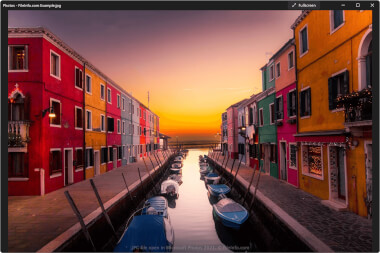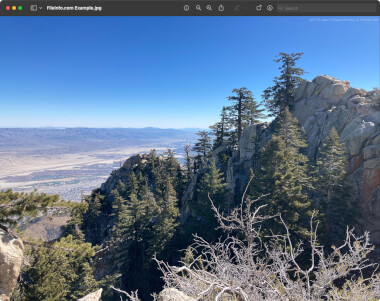.JPG File Extension
JPEG Image
| Developer | Joint Photographic Experts Group |
| Popularity |
4.0 | 3813 Votes |
What is a JPG file?
A JPG file is an image saved in the JPEG format. JPG files commonly contain digital photographs, drawings, or graphics. On most devices, you can double-click or double-tap a JPG file to open it in your default image viewer.
More Information
In 1992, the Joint Photographic Experts Group (JPEG) finalized and released the JPEG file format. Most notably, the JPEG format uses lossy compression to greatly reduce an image's file size with little loss in image quality. This makes it easy for users to store several hundred or thousand JPEGs, transfer them between devices, and share them via email and the internet.
Due to its utility, JPEG has become by far the most common digital image format. Many digital cameras and image editing programs save photos, drawings, and graphics as JPG files, and most every modern PC and smartphone includes a default image viewer that can open JPG files.
Is there a difference between JPG and JPEG files?
There is no difference between JPG and JPEG files. Both are images saved in the JPEG format. The reason many JPEG files use the .jpg extension is that early versions of Windows limited file extensions to three or fewer characters. Thus, JPEG images saved in Windows could not use the .jpeg extension, and they used .jpg instead.
Since Windows became the most popular PC operating system, .jpg became JPEG images' default extension. That's why, even now, JPG files are more common than JPEG files.
When to save images as JPG files
In most cases and for most users, saving an image as a JPG file is a good choice. While JPEG compression does slightly reduce an image's quality, the dip in quality is usually unnoticeable to the human eye. Additionally, many devices and programs that save JPGs allow you to adjust the image's compression and quality level, to fine-tune its file size and appearance.
However, there are times you should not save an image as a JPG file. For example, JPG images are typically not high-quality enough for use on printed banners, brochures, books, and magazines. In these cases, you may want to save your image as a .TIFF file. Also, the JPEG format does not support transparency and does not do well at retaining the edges of sharp-edged text or graphics. In these cases, you may want to save your image as a .PNG file.
How to open a JPG file
You can open a JPG file, and view the image it contains, with any image viewer. Common image viewers that support JPG files include:
You can also view a JPG image with any web browser, such as Google Chrome, Microsoft Edge, or Apple Safari, by dragging and dropping the file into your browser window.
How to edit a JPG file
Many image viewers that can open JPG files also contain simple image editing tools, such as the ability to crop and rotate an image and perform color adjustments. For example, Microsoft Photos, Apple Photos, and XnViewMP all contain basic image editing tools.
However, if you want to make more extensive edits to a JPG image, you should likely open and edit the image in a dedicated image editor. Some popular image editors include:
- Adobe Photoshop
- GIMP
- Inmagine Pixlr
How to convert a JPG file
Most programs that can open JPG files can convert them to other image formats. For example, Microsoft Photos can convert JPG files to the .PNG, .TIFF, .BMP, and .JXR formats, and Apple Photos can convert JPG files to the PNG and TIFF formats.
To convert a JPG file to another format, select your image viewer or editor's Save as or Export option. For example:
- In Microsoft Photos, select the ... button and then Save as.
- In Apple Photos, select File → Export → Export # Photos.
Then, choose the format to which you want to convert your JPG file and finish the saving or exporting process.
If you want to convert many JPG files to another format at once, however, you're better off using a batch conversion tool. For example, File Viewer Plus and Adobe Photoshop both include batch conversion tools that allow you to convert an entire set of JPG files to another image format all at once.

